users manual
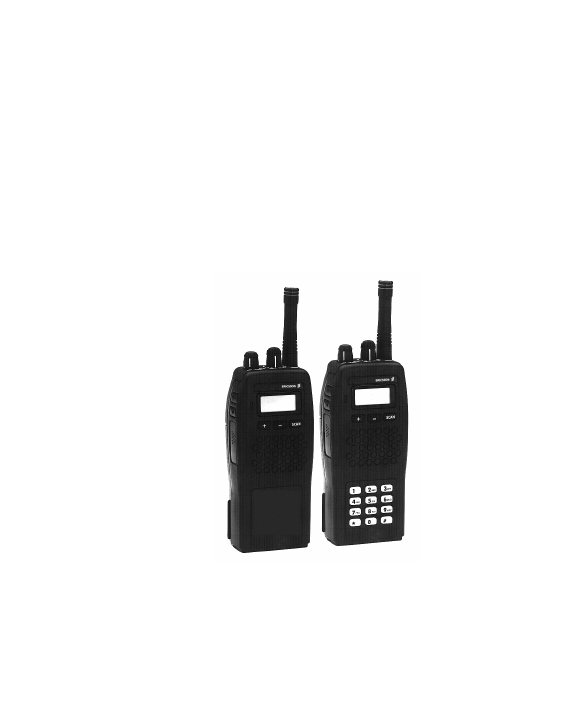
Operator's Manual
Portable Radio Unit
KH-500/600

2
NOTICE!
This manual covers Ericsson products manufactured
and sold by Ericsson Inc.
NOTE!
Repairs to this equipment should be made only by an
authorized service technician or facility designated by
the supplier. Any repairs, alterations or substitution of
recommended parts made by the user to this
equipment not approved by the manufacturer could
void the user's authority to operate the equipment in
addition to the manufacturer's warranty.
NOTE!
The software contained in this device is copyrighted
by Ericsson Inc. Unpublished rights are reserved
under the copyright laws of the United States.
This manual is published by
Ericsson Inc.,
without any warranty. Improvements and
changes to this manual necessitated by typographical errors, inaccuracies of current
information, or improvements to programs and/or equipment, may be made by
Ericsson
Inc.,
at any time and without notice. Such changes will be incorporated into new editions of
this manual. No part of this manual may be reproduced or transmitted in any form or by any
means, electronic or mechanical, including photocopying and recording, for any purpose,
without the express written permission of
Ericsson Inc.
Copyright © January 1999, Ericsson Inc.

3
TABLE OF CONTENTS
Page
INTRODUCTION ..............................................................6
BUTTONS AND KNOBS............................................ 13
INDICATORS...................................................................19
STATUS INDICATORS ............................................. 20
ALERT TONES........................................................... 21
OPERATION ....................................................................26
RECEIVING A MESSAGE........................................ 26
SENDING A MESSAGE............................................. 27
HOME CHANNEL OPERATION............................. 28
TYPE 99 OPERATION............................................... 29
SCAN OPERATION ................................................... 31
TELEPHONE INTERCONNECT CALLS
(KH-600 ONLY)........................................................... 40
EMERGENCY OPERATION.................................... 44
BATTERY INFORMATION...........................................45
CHARGE BEFORE USING....................................... 45
RECHARGING THE BATTERY.............................. 45
CONDITIONING THE BATTERY........................... 46
INSTALLING THE BATTERY PACK..................... 46
REMOVING THE BATTERY PACK....................... 47
BATTERY CARE & MAINTENANCE.................... 48
BATTERY RECYCLING........................................... 48
OPERATING TIPS ..........................................................49
EFFICIENT RADIO OPERATION .......................... 50

4
TABLE OF CONTENTS (CONT)
Page
ANTENNA CARE AND REPLACEMENT.............. 50
ELECTRONIC DEVICES.......................................... 51
AIRCRAFT .................................................................. 51
BLASTING AREAS .................................................... 51
POTENTIALLY EXPLOSIVE
ATMOSPHERES......................................................... 52
ACCESSORIES ................................................................53
INTRINSICALLY SAFE USAGE ..................................55
BATTERY PACKS...................................................... 56
ACCESSORIES ........................................................... 57
GLOSSARY ......................................................................58
WARRANTY ....................................................................61
NICKEL-CADMIUM BATTERY WARRANTY..........62
OPERATOR'S RADIO SETUP ......................................63

5
This page intentionally left blank

6
INTRODUCTION
The KH-500 (Scan) and KH-600 (DTMF) portable
radios are lightweight, full-featured radios that provide
reliable two-way communications on 1 to 16 channels.
The KH-500 radio contains three (3) buttons on the
front panel. The KH-600 contains three (3) buttons
along with a twelve (12) button DTMF pad on the front
panel. The scan function allows monitoring of any or all
channels. Any channel may be scanned with or without
a priority level. One channel can be programmed for
Priority 1 (P1) and another for Priority 2 (P2), with any
or all remaining channels programmed as non-priority
channels (S). There is also an Emergency GE-STAR
mode transmission capability. A LCD display provides
status display of the radio functions along with the
display of the selected channel number.

7
The Universal Device Connector (UDC), located on
the side of the radio, provides connections for external
audio accessories. This connector also allows the
radio system personnel to connect programming
equipment and program the per-channel and overall
radio features. Consult the radio dealer to determine
the programmed features of your radio. Features that
are programmable on a per-channel basis include:
•Receive Frequency
•Transmit Frequency
•Channel Busy Lock-Out
•Optional Squelch Tail Elimination (STE) for Analog
Channel Guard
•Channel Guard Encode/Decode (Analog or Digital)
•Type 99 Tone Decode
•CG/DCG Decode Tones/ Codewords
•CG/DCG Encode Tones/ Codewords
•Automatic Number Identification (ANI)
•RF Power (High or Low)

8
•Microprocessor Oscillator Shift in Receive mode
•Microprocessor Oscillator Shift in Transmit mode
•Channel Spacing (12.5 kHz or 25/30 kHz)
•Telephone Interconnect DTMF Keypad enable
(KH-600 only)
Features that are programmable on an overall radio
basis include:
•Display Backlighting
•Alert Tones
•Emergency GE-STAR (with or without Home
Channel)
•Three (3) DTMF Auto-Dial Telephone Numbers
(KH-600 only)
•Carrier Control Timer (CCT)
•Hi/Low RF Power Button Enable/Disable
•Scan Options
•CG Auto/Manual Reset
•A.N.I. Options
•Home Channel
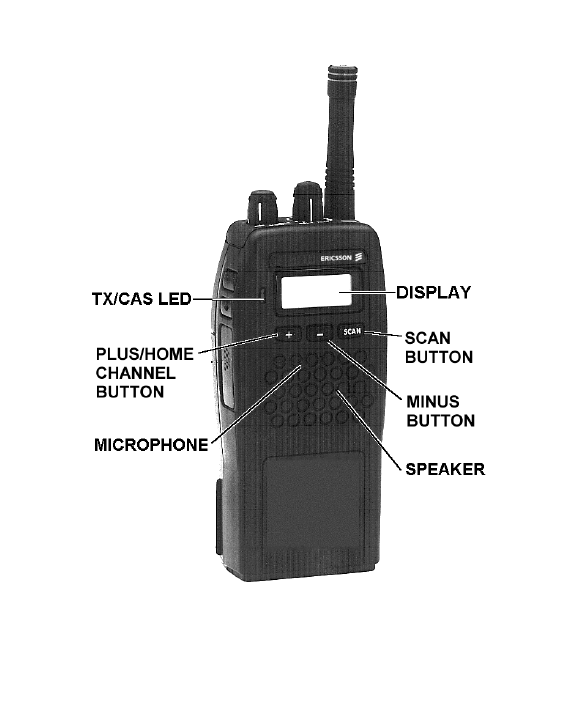
9
Figure 1 – KH-500 Scan Radio
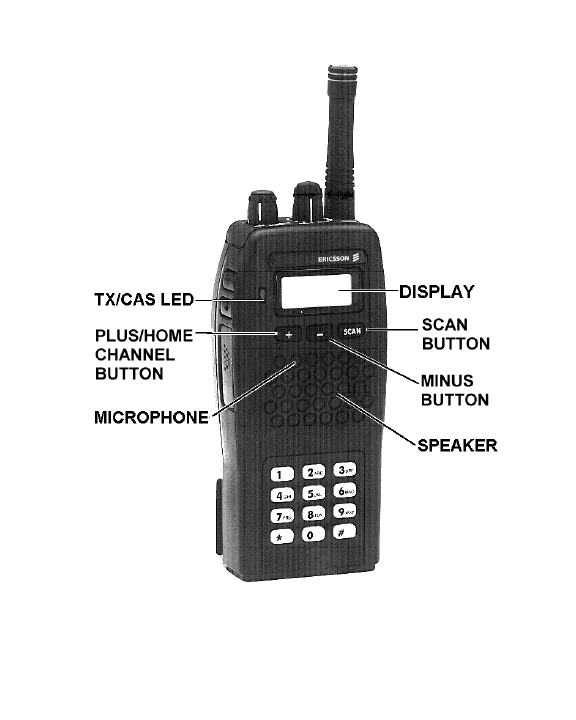
10
Figure 2 – KH-600 System Radio
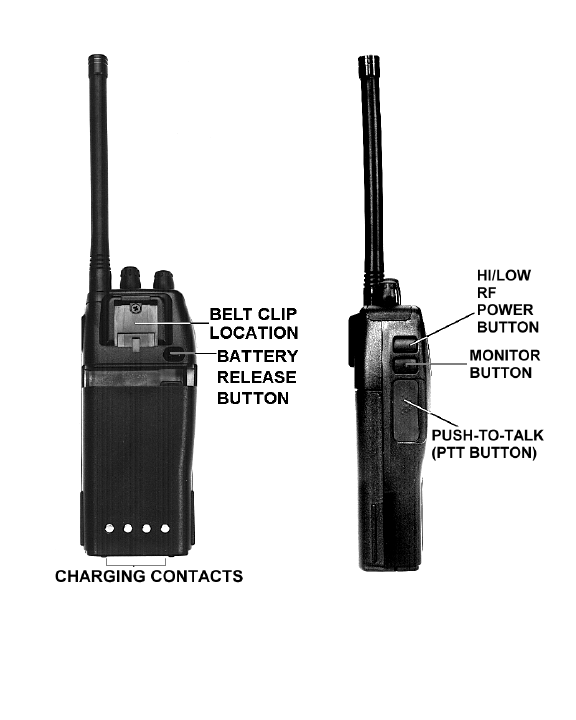
11
Figure 3 - Back And Left Panel Views
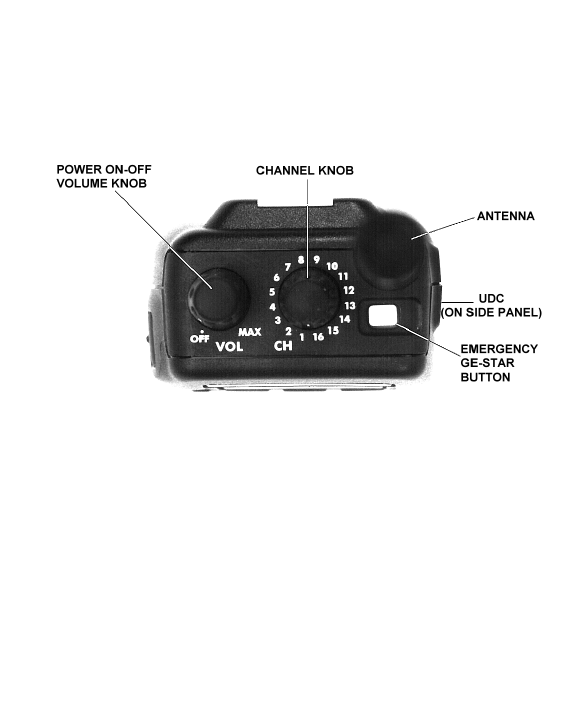
12
Figure 4 - Top, Back And Left Panel Views

13
BUTTONS AND KNOBS
This section describes the primary function of the
button and knob controls. Other functions associated
with these controls are detailed in later sections.
POWER
ON-OFF/
VOLUME
KNOB
Turns radio on and off and adjusts
audio listening level.
When the radio is turned on, it will
resume operation at the last
operating state (channel, etc.) and
the power-up alert tones will be
sounded. Three (3) beeps indicate
the radio is in the normal (receive
mode); four (4) beeps indicates the
radio is scanning. The operating
status of the radio will be displayed
in the Liquid Crystal Display (LCD)
window.
Rotating the control clockwise
increases the volume level.

PUSH-TO-TALK
BUTTON (PTT) Pressing the PTT button on the
side of the radio will key the radio
transmitter.
If the radio is not scanning, it will
transmit on the selected
(displayed) channel. If the radio is
scanning when the PTT button is
pressed, the radio may be
programmed to transmit on the
selected channel or on the current
receive scan channel if the PTT is
pressed during the scan hang time.
If the selected channel is
programmed with Type 99 Tone
Decode enabled, pressing the PTT
button once will disable Type 99
Tone Decode by switching the
radio from the Selective Call mode
to the Monitor mode. The PTT
button must be released and then
pressed a second time to key the
radio.

15
MONITOR
BUTTON The Monitor button has several
functions. Its operation will vary
depending upon programming.
When the Monitor button is
pressed and held down, all
transmissions will be heard even if
Channel Guard protected. This
permits channel monitoring before
transmitting. If the button is held for
more than one second, Channel
Guard decode will toggle ON or
OFF (if it is programmed on the
selected channel).
The Monitor button is also used to
reset the Type 99 decoder after a
Type 99 call is received. Quickly
press and release the button to
reset the Type 99 decoder to
receive the next Type 99 call.

16
CHANNEL
SELECT
KNOB
A rotary switch permits selection of
channels. Rotating the switch
clockwise increases the channels
and counterclockwise decreases
the channels. The channel is
visible by looking at the channel
switch from the top or viewing the
LCD display.
EMERGENCY
GE-STAR
BUTTON
Pressing for at least one (1)
second will transmit the
Emergency GE-STAR code on the
selected channel or a pre-
programmed HOME channel.
Hi/Low
BUTTON Pressing for at least one (1)
second selects the transmit power
output by toggling from high-low or
low-high. Must be pre-programmed
for operation.

17
Three (3) buttons below the LCD display are used
to control scan operations when used in conjunction
with the button.
Toggles the scan feature on and off.
Used in conjunction with the
button to add channels to the scan list
or increase the channel's priority
status.
Home Channel button (if programmed
in personality)
Used in conjunction with the
button to erase the selected channel
from the scan list.
Used to decrease the level during
squelch adjust mode.

18
DTMF Keypad
(KH-600 only) Permits operator to make telephone
interconnect calls on radio systems
equipped with this option.
The top row of buttons (, ,
) provide access to up to three
pre-programmed telephone
interconnect numbers (see
Telephone Interconnect Calls
section).

19
INDICATORS
The Liquid Crystal Display (LCD) indicates the
channel number. In addition there are seven (7) status
indicators (flags) which show scan status, Type 99
Tone Decode status, transmit High/Low power status
and Channel Guard status.
The LCD backlighting will turn on anytime a control
button is pressed. It will remain on for five (5) seconds
after the button is released. If a control button is
pressed while the backlight is on, the backlight remains
on for another five (5) seconds. Backlighting may be
programmed to remain off at all times.
SCN HI
S P1 P2
PG CG
Figure 5 - Liquid Crystal Display (LCD)
CHANNEL
12 The selected channel number is
displayed in the LCD window. When
data is written into or read from the
radio during PC programming, a P is
displayed.

20
STATUS INDICATORS
SCN This status indicator turns on when the
scan function of the radio has been
enabled.
SWhen this indicator is on, the selected
channel is a non-priority scan channel.
P1 When this indicator is on, the selected
channel is a Priority 1 scan channel.
P2 When this indicator is on, the selected
channel is a Priority 2 scan channel.
PG When this indicator is on, the selected
channel is programmed as a paging
channel (Type 99 Decode). The
indicator will blink when the selected
channel is placed in the monitor mode
or upon the reception of a call.
CG When this indicator is on, Channel
Guard is enabled on the selected
channel. The indicator will go out
when the selected channel is placed in
the monitor mode.

21
HI When this indicator is on, the selected
channel is enabled for transmit high
power.
TX/CAS LED Red light on steady - transmitter is
active or keyed.
Red light blinking - low battery voltage,
recharge or replace battery.
Green on steady - channel busy
indication, radio has detected a carrier
on selected channel.
ALERT TONES
Alert tones or "beeps" are sounded when some
buttons are pressed and when the operating status of
the radio changes. All alert tones may be programmed
to be remain off. The volume level of some alert tones
or "beeps" can be changed by the volume control.

22
Power-up Self-test
Each time the radio is turned on, it will perform
power-up self-test. All display segments will turn on,
and after successful completion of the test, the radio
will change to the last operating state (channel, etc.)
and sound three (3) or four (4) beeps. Three (3) beeps
sound if the radio is operating in the normal (not scan)
state. Four (4) beeps will sound if the radio is
scanning. The status will be indicated in the LCD. If the
radio fails the self-test, no beeps will be sounded.
Carrier Control Timer
This feature, programmable on a per-radio basis,
prevents unnecessary channel traffic and radio
damage if the transmit timer limit is exceeded. If the
programmed timer times-out during a transmission, the
radio will beep and stop transmitting. The beeping tone
will continue until the operator releases the PTT
button. Releasing the PTT button resets the timer.

23
Channel Busy Lock-out
If channel busy lock-out has been programmed on
the selected channel, the transmit function will be
inhibited when the operator press the PTT button while
the radio detects a carrier on the channel unless the
carrier is modulated with the corresponding Channel
Guard tone or code for that selected channel. Channel
busy lock-out continues to function if Channel Guard
decode is disabled with the MONITOR button. The
channel-busy feature is programmable on a per-
channel basis.
Type 99 Alert Tone
The Type 99 alert tone, indicating a receive Type
99 call, may be enabled or disabled by programming. If
the programmed tone sequence is detected, the radio
will beep until the second paging tone expires. If the
alert tones are disabled, no alert tones will be present
when a Type 99 call is received.
The Type 99 alert tones can only be turned off by
disabling ALL alert tones.
NOTE

24
A.N.I. Alert Tone
If the A.N.I. transmission is programmed to occur
before the beginning of the conversation, an optional
Automatic Number Identification (A.N.I.) alert beep can
be enabled or disabled by programming. If the alert
tone is enabled, a beep will sound after the PTT is
pressed to indicate to the operator to begin voice
transmission. Some communication systems require a
time delay before voice transmission begins. If the alert
tone is disabled, no beep will sound.
Scan Alert Tone
The radio will sound a beep when the button is
pressed.
Priority-One (P1) Scan
If the Priority 1 alert tone is enabled by
programming and the radio receives a signal on the
Priority 1 channel when scanning, the radio will sound
a beep. The P1 alert tone can be disabled without
disabling other alert tones.

25
Radio/Channel Failure
The simultaneous flashing of the LCD display and
the sounding of beeps indicates the synthesizer is
unable to correctly lock on the selected channel. At this
time the radio changes to a mute condition and no
audio is heard from the speaker when receiving and
the transmit is inhibited if the PTT button is pressed.
Select another channel, change the battery pack or
have the radio repaired.

26
OPERATION
RECEIVING A MESSAGE
1. Turn the radio on by rotating the
ON/OFF/VOLUME control clockwise from the "off"
detent. After the radio has successfully completed
its power-up self-test, it will begin operation at the
last operating state (channel, etc.). The operating
status of the radio will be displayed on the LCD. If
enabled, the power-up alert tones (three or four
beeps) will be sounded.
2. Select the desired operating channel by rotating
the CHANNEL SELECT control until the desired
channel number appears on the LCD.
3. When a transmission is received (and the correct
CG/DCG or Type 99 signal is decoded, if
programmed and enabled), the receiver will
unsquelch and the message will be heard in the
speaker.
4. Adjust the volume as necessary by rotating the
ON/OFF/VOLUME control.

27
Pressing the MONITOR button unsquelches the
receiver for the first three (3) seconds the button is
held. All transmissions will be heard, even if
Channel Guard protected. If it is held for more than
three (3) seconds, the Channel Guard decoder will
be toggled on or off (if programmed for the selected
channel).
SENDING A MESSAGE
1. Turn the radio on and select the desired operating
channel as described in
RECEIVING A
MESSAGE
.
2. Press the MONITOR button to determine if the
channel is in use or observe the TX/CAS LED
which shows green if the channel is busy.
Never
interrupt another transmission.
3. Hold the radio so the antenna is vertical and press
and hold the PTT button when you are ready to
transmit. Speak directly into the grill or across the
face of the radio or external microphone. Release
the PTT button when you are finished talking.
Messages cannot be received and heard when the
PTT button is pressed.
NOTE

28
When transmitting on a paging channel (Type 99, if
programmed), the PTT button must be pressed
twice. The first press takes the radio out of
Selective mode. The second press keys the
transmitter for normal transmitter operation.
HOME CHANNEL OPERATION
A Home Channel feature is available if programmed
into the personality. This can stand alone or be used
in conjunction with Emergency GE-STAR. If Stand
Alone Home Channel and Emergency GE-STAR with
Home Channel are selected, then the same channel
must be selected as the Home Channel.
1. Press and hold the button for more than
1-second. The channel number on the LCD will
change to identify the Home Channel. Pressing
the button for less than 1-second will be
considered inadvertent, and switching to the Home
Channel will not occur.
2. Within 5 seconds press another button to confirm
the Home Channel selection. If another button is
not pressed, the KH will revert to the channel
defined by the Channel Select knob. The KH will
remain on the Home Channel until the Channel
Select knob is moved to a new position.
NOTE

29
TYPE 99 OPERATION
The radio may be programmed to power up in the
Selective mode or in the Monitor mode. If the Selective
mode is programmed and a Type 99 channel is
selected at power up, the PG status flag will illuminate.
If the Monitor mode is programmed and a Type 99
channel is selected, the PG status flag will blink.
When the radio is operating in the Selective mode,
it operates as a tone and voice receiver and only those
calls that are coded for it will be heard.
When the radio is operating in the Monitor mode, all
calls (with correct Channel Guard, if programmed) will
be heard.
In either mode, when a Type 99 channel has been
selected and a valid code is received, a series of alert
tones (if programmed) will alert the operator of the
incoming call. If the radio is in the Selective mode, it
will automatically switch to the Monitor mode after the
detection of the second Type 99 tone.

30
If the radio was programmed to power up in the
Selective mode, changing positions on the channel
select switch will always place a Type 99
programmed channel in the Selective mode. If the
radio was programmed to power up in the Monitor
mode, changing positions on the channel select
switch will always place a Type 99 channel in the
Monitor mode.
Type 99 Selective Call Receiving and Sending
1. Select the appropriate channel to receive the Type
99 tone signal.
2. After a Type 99 call is received and the beeps
have sounded, press the PTT button and answer
the call. When the communication sequence is
completed, press the MONITOR button to reset
the radio for the next call.
3. When the radio is reset (Selective mode), Type 99
operation can be disabled by pressing and
releasing the PTT button. The PG status flag will
blink. No transmission occurs. A second press of
the PTT button will result in a normal transmission.
NOTE

31
4. To return to Type 99 Selective mode, press the
MONITOR button. The PG status flag will be on.
SCAN OPERATION
The radio may be programmed for a front panel
selectable Priority 1 (P1) channel, a fixed pre-
programmed P1 channel or a selected P1 channel. A
scan list must be created before scan operation can be
used. All non-priority (S) channels and the Priority 2
(P2) channel are added or deleted from the scan list by
using in conjunction with and .
A front panel selectable P1 channel permits the
operator to modify the scan list by using the button
in conjunction with the or keys.
A fixed P1 channel has already been pre-
programmed and cannot be changed.
A selected P1 channel becomes the channel
selected by the CHANNEL SELECT control.
Each channel in the scan list is retained in memory
when the radio is turned off or when the battery pack is
removed.

32
Starting Or Stopping Scan
Press the button to turn on the scan function.
The SCN status flag will come on. To turn off the
scanning function, press the button and the SCN
status flag will go off.
Receiver Scan Rate
Scan rate will vary depending upon the number of
channels on the scan list and whether scanning for
Channel Guard. Fewer channels on the scan list or not
scanning for Channel Guard will result in a faster scan
rate.
There are three types of Scan condition: simple
scan, priority scan and Channel Guard scan.
When Scan function is turned on, the radio will
perform a simple scan on all channels on the scan list
plus the channel selected by the CHANNEL SELECT
switch although that channel may not be on the scan
list. Once activity is detected (and if programmed, the
correct Channel Guard is decoded) on a channel, the
radio changes the scanning mode from simple scan to
priority scan. The channel with activity will be indicated

33
in the LCD display along with the corresponding status
flag, S, P1 or P2.
The scan function is now in the priority scan mode
and scanning will be determined by the following
conditions:
•NON-PRIORITY PROGRAMMED CHANNELS -
The radio will lock on the channel until activity on
the channel ceases. The scanning will resume
after a pre-programmed time delay.
•PRIORITY 1, NON-PRIORITY PROGRAMMED
CHANNELS - If the receive channel is non-priority,
the radio will sample the Priority 1 channel for
activity. Priority 1 channel will continue to be
sampled while remaining on the non-priority
channel until the carrier ceases and scanning
resumes after a pre-programmed delay. Should
activity be detected during a sampling of the
Priority 1 channel, the radio will switch to the
Priority 1 channel and remain there until activity
ceases on the Priority 1 channel. Once activity
ceases on the Priority 1 channel, scanning will
resume after a pre-programmed delay.

34
If the receive channel is Priority 1, the radio will
lock onto this channel for the duration of the
activity and no other channels will be scanned.
After the activity ceases, scanning will resume
after a pre-programmed delay.
•PRIORITY 2, NON-PRIORITY PROGRAMMED
CHANNELS - This condition operates similar to
the above with the Priority 2 replacing the Priority 1
references.
•PRIORITY 1, PRIORITY 2, NON-PRIORITY
PROGRAMMED CHANNELS - If the receive
channel is non-priority, the radio will sample the
Priority 1, return to the non-priority channel, then
sample the Priority 2 channel. This sampling will
continue until activity ceases on the non-priority
channel or activity is detected on either of the
Priority channels. If activity is detected on the
Priority 2 channel, the radio will lock onto that
channel but will continue to sample the Priority 1
channel for activity. Should activity be detected on
the Priority 1 channel while locked onto the Priority
2 channel, the radio will switch to the Priority 1
channel and remain there for the duration. After
activity ceases, scanning will resume after a pre-
programmed delay.

35
If activity is detected on the Priority 2 channel
instead of Priority 1 or a non-priority channel, the
radio will sample the Priority 1 channel for activity.
The radio will remain locked onto the Priority 2
channel for the duration of the activity unless the
sampling of the Priority 1 channel detects activity.
If this occurs, the radio will lock onto the Priority 1
channel for the duration of the activity. Scanning
will resume after a pre-programmed time delay.
If activity is detected on the Priority 1 channel
instead of Priority 2 or a non-priority channel, the
radio will lock onto the Priority 1 channel for the
duration of the activity. Scanning will resume after
a pre-programmed delay.

36
Adding Channels To Scan List
1. Scan must be off to add channels to the scan list.
If the SCN status flag is on, press the button to
turn scan off.
2. Select the desired channel with the CHANNEL
SELECT control.
3. Press and hold the button and then repeatedly
press the key until the desired Priority status
flag appears: S for non-priority, P2 for Priority 2 or
P1 for Priority 1.
Priority 1 can only be selected by the operator if the
radio is programmed for front panel selectable scan
option.
4. If a new Priority 1 or Priority 2 channel is selected,
the previously corresponding priority channel will
become a non-priority scan channel.
NOTE

37
Deleting Channels From Scan List
1. Scan must be off to delete channels from the scan
list. If the SCN status flag is on, press the
button to turn scan off.
2. Select the desired channel with the CHANNEL
SELECT control.
3. Press and hold the button and then press the
button to delete the selected channel from the
scan list.
Priority 1 can only be deleted by the operator if the
radio is programmed for front panel selectable P1
channel option.
NOTE

38
Using The Radio With Scan
The Selected Channel
The selected channel is the channel in the display
when scan is turned on by the button. The
selected channel does not necessarily have to be a
channel on the scan list. When a signal is not being
received, the radio reverts to this channel for
transmitting. When a signal is being received, the radio
can be pre-programmed to either revert to this selected
channel or remain on the receive channel for
transmissions.
If the radio was pre-programmed for transmit on the
selected channel, the selected channel will be
displayed on the LCD when the transmitter is keyed.
If the radio was pre-programmed for transmit on the
receive channel, the channel will be displayed on the
LCD and the transmitter will transmit on that channel
providing this is accomplished during the pre-
programmed time delay before scanning resumes.

39
Should the operator change the channel with the
CHANNEL SELECT control during scanning, the new
channel will become the selected channel. If the
selected channel is changed to a channel not in the
scan list, the new channel will be temporarily added to
the scan list until the selected channel is changed
again or scan function is turned off.
Scanning With Channel Guard
Any channel in the scan list can be scanned not
only for activity but for correct Channel Guard tones or
DCG codewords. The correct tone or codeword will
permit scanning to lock onto that channel with activity.
If the radio detects activity but without the correct tone
or code, the green BUSY LED will light but no audio
will be heard from the speaker.

40
TELEPHONE INTERCONNECT CALLS
(KH-600 ONLY)
The operator may make telephone interconnect
calls on radio systems equipped for this option. One of
three pre-programmed numbers can be selected and
dialed automatically using either of the three keys on
the top row of the DTMF keypad. The telephone
numbers may also be manually dialed using the
keypad.
Communication takes place in a simplex mode. In
other words, you cannot talk and listen at the same
time. You must press and hold the PTT button each
time you wish to talk (transmit) and release it when you
wish to listen (receive).

41
Specific procedures for placing a telephone
interconnect call from the radio are determined by the
radio system and the individual radio programming.
Consult your radio dealer for the exact operating
procedures necessary for your system and radio.
Pre-programmed Number
1. Select the channel in your radio system that has
telephone interconnect capability using the
CHANNEL SELECT control.
2. Press and hold the PTT button and momentarily
press the button to activate the auto-dialer.
3. While still holding the PTT button, momentarily
depress one of the keys (, , ) to select
the desired pre-programmed number.
4. Release the PTT button. The microphone will be
muted and the DTMF tones will be heard in the
speaker as the radio sends the selected number.
5. When the called party answers, press the PTT
button each time you wish to speak (transmit) and
release it each time you wish to listen (receive).

42
6. At the completion of the call, press and hold the
PTT button and then press the appropriate DTMF
buttons to send the disconnect tone(s) and remove
the radio from the telephone interconnect function.
Consult with the radio dealer for the procedure to
disconnect a telephone interconnect call from the
system.
NOTE

43
Placing A Manually Dialed Call
1. Select a channel in your radio system that has
telephone interconnect capability by using the
CHANNEL SELECT control.
2. Press and hold the PTT button and then press the
DTMF buttons (as required by the radio system) to
originate a telephone interconnect call. The radio
will transmit the selected tone.
3. Release the PTT button and listen for a dial tone.
4. Press and hold the PTT button and then dial the
desired telephone number using the numeric
keypad. As each number is dialed, the DTMF tone
will be heard in the speaker.
5. Release the PTT button when the dial sequence is
complete.
6. When the called party answers, press and hold the
PTT button each time you wish to speak (transmit)
and release it each time you wish to listen
(receive).
7. At the completion of the call, press and hold the
PTT button and then press either the DTMF
buttons (as required by the radio system) to
disconnect from the telephone interconnect
function.

44
EMERGENCY OPERATION
If enabled by pre-programming, GE-STAR
emergency signaling can be transmitted when the
Emergency button is pressed and held for one second.
This Emergency GE-STAR ID can be pre-programmed
to be sent on the channel selected by the CHANNEL
SELECT control or a pre-programmed Home Channel.
The red TX indicator will light and the radio proceeds
to transmit the Emergency GE-STAR ID for the
programmed time interval and number of times (1 to 15
or unlimited, pre-programmed). If programmed for
unlimited times, the emergency operation will continue
until the battery is dead or the radio is turned OFF and
then back ON.
Should the Emergency GE-STAR button be
pressed when the radio is in scanning operation, the
radio will stop scanning, perform the transmission of
the GE-STAR ID emergency signaling and then
resume normal operation.
The emergency state can be cleared by turning the
radio off and then back on.

45
BATTERY INFORMATION
CHARGE BEFORE USING
Insert the radio into the slot on the charger and
ensure that the ON/OFF/VOLUME control is in the
OFF position. Connect charger to a 120 VAC outlet.
An optional 230 VAC charger may be needed for
international applications. Charge the battery for the
first time at least 14 hours but no longer than 48 hours.
Over-charging may reduce battery life.
RECHARGING THE BATTERY
Recharge the battery when you experience difficulty
in receiving or sending a message. Also the battery
may need recharging when the red TX indicator is
blinking.
Chargers are available with nominal charge times
of one to 14 hours. Combinations include single and
multiposition chargers. When charging a battery pack
that is attached to a radio, always turn the radio OFF to
ensure a full charge. For specific instructions, refer the
applicable charger Operator's Manual. Charging in
non-Ericsson equipment may lead to battery damage
and void the battery warranty.

46
CONDITIONING THE BATTERY
Batteries which have been stored (charged or
discharged) will generally not be capable of full
capacity until the batteries have been fully cycled two
or three times. (Charging the battery in an Ericsson
rapid charger and then discharging the battery pack
with the radio until low battery is indicated is
considered one cycle.)
INSTALLING THE BATTERY PACK
1. Ensure the ON/OFF/VOLUME control knob is in
the OFF (detent) position.
2. Align the battery pack tabs with the battery
mounting plate slots on the back of the radio (see
Figure 6).
3. Insert the tabs into the slots, push down and slide
the battery toward the battery latch until the battery
latch clicks into place.
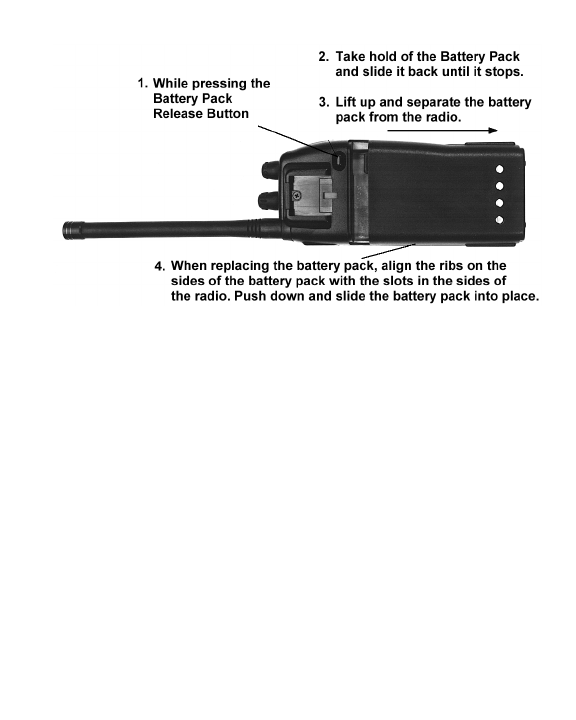
47
Figure 6 - Installing And Removing The Battery Pack
REMOVING THE BATTERY PACK
1. Ensure the ON/OFF/VOLUME control know is in
the OFF (detent) position.
2. Press the battery release button to release the
battery.
3. Remove the battery pack by sliding it back until it
stops. Then lift up and away until it separates from
the radio.

48
BATTERY CARE & MAINTENANCE
•Your charger is intended for indoor use only. Keep
the charger and/or wall cube dry. Do Not use in or
near water.
•Never let the battery contacts touch metal objects
that could short-circuit the contacts. For example,
keys or coins in your pocket.
•Do Not disassemble a battery.
•Do Not dispose of a battery in a fire.
•Use only the supplied or specified battery and
charger.
•Periodically condition your battery for improved
battery capacity and performance.
BATTERY RECYCLING
The product that you have purchased
contains a rechargeable, recyclable battery.
At the end of its useful life, under various
state and local laws, it may be illegal to dispose of this
battery into the municipal waste stream. Check with
your local solid waste officials for details in your area
for recycling options or proper disposal. Call Toll Free
1-800-8-BATTERY for information and/or procedures
for returning rechargeable batteries in your state.

49
OPERATING TIPS
Antenna location and condition is important when
operating a portable radio. Operating the radio in low
areas or terrain, under power lines or bridges, inside of
a vehicle or in a metal or steel framed building can
severely reduce the range of the unit. Mountains and
buildings can also reduce the range of the unit.
In areas where transmission or reception is poor,
some improvement may be obtained by ensuring that
the antenna is vertical. Moving a few yards in another
direction or moving to a higher elevation may also
improve communications. Vehicular operation can be
aided with the use of an externally mounted antenna.
Battery condition is another important factor in the
trouble free operation of a portable radio. Always
properly charge the batteries.

50
EFFICIENT RADIO OPERATION
Hold the portable radio approximately three inches
from your mouth and speak into the microphone at a
normal voice level.
Keep the antenna in a vertical position when
receiving or transmitting a message.
Do not hold the antenna when receiving a message
and, especially, do not hold when transmitting a
message.
ANTENNA CARE AND REPLACEMENT
Do not use the portable radio with a damaged or
missing antenna. A minor burn may result if a
damaged antenna comes into contact with the skin.
Replace a damaged antenna immediately. A missing
antenna could damage your portable radio.
Use only the supplied or approved antenna.
Unauthorized antennas, modifications or attachments
could damage the radio unit and may violate FCC
regulations.

51
ELECTRONIC DEVICES
RF energy from your portable radio may affect
some electronic equipment. Most modern electronic
equipment in cars, hospitals, homes, etc. are shielded
from RF energy. However, in areas that instruct you to
turn off two-way radio equipment, always observe the
rules. If in doubt, turn it off.
AIRCRAFT
Always turn off your portable radio before boarding
any aircraft.
•Use it on the ground only with crew permission
•Do not use it in the air
BLASTING AREAS
To avoid interfering with blasting operations, turn
your radio OFF when in a "blasting area" or in areas
posted "turn off two-way radio". Remote control RF
devices are used by some construction crews to set off
explosives.

52
POTENTIALLY EXPLOSIVE ATMOSPHERES
Areas with potentially explosive atmosphere are
often, but not always, clearly marked. These may be
fueling areas, such as gas stations, fuel or chemical
transfer or storage facilities, and areas where the air
contains chemicals or particles, such as grain, dust or
metal powders.
Sparks in such areas could cause an explosion or
fire resulting in bodily injury or even death.
Turn OFF your radio when in any area with a
potentially explosive atmosphere. It is rare, but not
impossible that the radio or its accessories could
generate sparks.

53
ACCESSORIES
The following accessories are available for use with
the KH-500/600 radio units:
Antenna, 136-155 MHz, Helical KRE 101 1219/1
Antenna, 150-165 MHz, Helical KRE 101 1219/2
Antenna, 160-174 MHz, Helical KRE 101 1219/3
Antenna, 403-440 MHz, Helical KRE 101 1219/10
Antenna, 440-470 MHz, Helical KRE 101 1219/12
Antenna, 470-512 MHz, Helical KRE 101 1219/13
Antenna, 403-440 MHz, Whip KRE 101 1223/10
Antenna, 440-512 MHz, Whip KRE 101 1223/12
Rechargeable Battery Pack
(Extra High Capacity) BKB 191 202
Rechargeable Battery Pack
(High Capacity) BKB 191 203
Speaker/Microphone
(Ericsson Label) KRY 101 1617/33
Earpiece RLD 541 07/11
Rapid Charger, 120/230 VAC
(Ericsson Label) BML 161 51/505
Multi-Rapid Charger, 120/230 VAC
(Ericsson Label) BML 161 51/513

54
ACCESSORIES CONTINUED
Compact Rapid Charger, 120/230 VAC
(Ericsson Label) BML 161 74/12
International Plug Adapter Kit
(For use with BML 161 74/12 only) BML 161 74/21
Belt Clip KRY 101 1232/2
Belt Loop with Swivel Mount KRY 101 1609/A1
Leather Case w/Belt Loop KRY 101 1622/1
Leather Case w/ Belt Loop & swivel KRY 101 1622/A2
Shoulder Strap
(For Leather Case) KRY 101 1607/1

55
INTRINSICALLY SAFE USAGE
Selected portable radios with appropriate factory
installed options are certified as Intrinsically Safe by
the Factory Mutual Research Corporation and the
Canadian Standards Association. Intrinsically Safe
approval through Factory Mutual includes Class I, II,
III, Division 1 hazardous locations in the presence of
Groups C, D, E, F and G atmospheres. Non-Incendive
approval includes Class I, Division 2 hazardous
locations in the presence of Groups A, B, C and D
atmospheres. Approval through the Canadian
Standards Association (CSA) includes Class I Groups
C and D, Class II Group G Coal Dust; and Class III.
CSA approval also includes Class I, Division 2 Groups
A, B, C and D.
Hazardous locations are defined in the National
Electrical Code. Useful standards NFPA 437A and
NFPA 437M for the classifications of hazardous areas
can be ordered from the National Fire Protection
Association, Batterymarch Park, Quincy, MA 02269.

56
BATTERY PACKS
Only battery packs identified with a green FM/CSA
label shall be used with a portable radio that is rated
and labeled as Factory Mutual/CSA Intrinsically Safe.
Use of nonspecified battery packs voids Factory
Mutual/CSA approval. The following battery packs are
approved for use in intrinsically safe radios:
BKB 191 202/2 Rechargeable Battery Pack,
Extra High Capacity
BKB 191 203/2 Rechargeable Battery Pack,
High Capacity

57
ACCESSORIES
Use of accessories other than those listed voids
Factory Mutual/CSA approval. The following
accessories are for use with intrinsically safe radios:
Speaker/Microphone/Antenna
(Ericsson Label) KRY 101 1617/31
Earpiece Kit RLD 541 07/11
Antenna, 136-155 MHz, Helical KRE 101 1219/1
Antenna, 150-165 MHz, Helical KRE 101 1219/2
Antenna, 160-174 MHz, Helical KRE 101 1219/3
Antenna, 403-440 MHz, Helical KRE 101 1219/10
Antenna, 440-470 MHz, Helical KRE 101 1219/12
Antenna, 470-512 MHz, Helical KRE 101 1219/13
Antenna, 403-440 MHz, Whip KRE 101 1223/10
Antenna, 440-512 MHz, Whip KRE 101 1223/12
Belt Clip KRY 101 1232/2
Belt Loop w/swivel KRY 101 1609/A1
Leather Case w/Belt Loop KRY 101 1622/1
Leather Case w/ Belt Loop & swivel KRY 101 1622/A2
Shoulder Strap
(for leather case) KRY 101 1607/1

58
GLOSSARY
conventional
channel - a radio channel (transmit/receive) that is
allocated for conventional (non-trunked) use
and may be manually selected by the
operator.
conventional mode - communicating on radio channels allocated
for conventional use.
CCT - Carrier Controlled Timer - a programmable
timer that will disable a transmission if the
timer length is exceeded.
CG - Channel Guard - a method of controlling
receiver mute with a tone or digital code.
Talk-around mode - also referred to as "direct mode", talk-
around provides a direct unit-to-unit short
range communications link. It is intended to
maintain communications outside of the
main system coverage area.
Telephone
Interconnect - this feature allows the user to initiate or
receive telephone calls through the radio if
the system is configured for this operation.
(Trunked Mode Only)

59
Channel
Number TX Freq
(MHz) Encode
CG/DCG RX Freq
(MHz) Decode
CG/DCG USE
1
2
3
4
5
6
7
8
9
10
11
12
13
14
15
16

60
NOTES

WARRANTY
A Ericsson Inc. (hereinafter "Seller") warrants to the original purchaser for use (hereinafter "Buyer") that
Equipment manufactured by Seller shall be free from defects in material, workmanship and title, and shall
conform to its published specifications. With respect to any Equipment not manufactured by Seller (except for
integral parts of Seller's Equipment to which the warranties set forth above shall apply). Seller gives no
warranty, and only the warranty, if any, given by the manufacturer shall apply. Batteries are excluded from this
warranty but are warranted under a separate Nickel-Cadmium Battery Warranty.
B. Seller's obligations set forth in Paragraph C below shall apply only to failures to meet the above warranties
(except as to title) occurring within the following periods of time from date of sale to the Buyer and are
conditioned on Buyer's giving written notice to Seller within thirty (30) days of such occurrence:
1. for fuses, incandescent lamps, vacuum tubes and non-rechargeable batteries, operable on arrival only.
2. for parts and accessories (except as noted in B.1) sold by Seller's Service Parts Operation, ninety (90)
days.
3. for all other Equipment of Seller's manufacture, one (1) year.
C. If any Equipment fails to meet the foregoing warranties, Seller shall correct the failure at its option (i) by
repairing any defective or damaged part or parts thereof, or (ii) by making available at Seller's factory any
necessary repaired or replacement parts. Any repaired or replacement part furnished hereunder shall be
warranted for the remainder of the warranty period of the Equipment in which it is installed. Where such failure
cannot be corrected by Seller's reasonable efforts, the parties will negotiate an equitable adjustment in price.
Labor to perform warranty service will be provided at no charge during the warranty period only for the
Equipment covered under Paragraph B.3. To be eligible for no-charge labor, service must be performed by an
Authorized Service Center or other Servicer approved for these purposes either at its place of business during
normal business hours, for mobile or personal equipment, or at the Buyer's location, for fixed location
equipment. Service on fixed location equipment more than thirty (30) miles from the Service Center or other
approved Servicer's place of business will include a charge for transportation.
D. Seller's obligations under Paragraph C shall not apply to any Equipment, or part thereof, which (i) has
been modified or otherwise altered other than pursuant to Seller's written instructions or written approval or, (ii)
is normally consumed in operation or, (iii) has a normal life inherently shorter than the warranty periods
specified in Paragraph B, or (iv) is not properly stored, installed, used, maintained or repaired, or, (v) has been
subjected to any other kind of misuse or detrimental exposure, or has been involved in an accident.
E. The preceding paragraphs set forth the exclusive remedies for claims (except as to title) based upon
defects in or nonconformity of the Equipment, whether the claim is in contract, warranty, tort (including
negligence), strict liability or otherwise, and however instituted. Upon the expiration of the warranty period, all
such liability shall terminate. The foregoing warranties are exclusive and in lieu of all other warranties, whether
oral, written, expressed, implied or statutory. NO IMPLIED OR STATUTORY WARRANTIES OF
MERCHANTABILITY OR FITNESS FOR PARTICULAR PURPOSE SHALL APPLY. IN NO EVENT SHALL
THE SELLER BE LIABLE FOR ANY INCIDENTAL, CONSEQUENTIAL, SPECIAL, INDIRECT OR
EXEMPLARY DAMAGES. This warranty applies only within the United States.
ECX-886A (1/95)

62
NICKEL-CADMIUM BATTERY WARRANTY
A. Ericsson Inc. (hereinafter "Seller") warrants to the original purchaser for use
(hereinafter "Buyer") that nickel-cadmium batteries supplied by Seller shall be free from
defects in material and workmanship, and shall conform to its published specifications for a
period of twelve (12) months from the date of purchase.
B. For purposes of this warranty, batteries shall be deemed defective if (1) the battery
capacity is less than 80% of rated capacity, or (2) the battery develops leakage.
C. If any battery fails to meet the foregoing warranty, Seller shall correct the failure by
issuing a replacement battery upon receipt of the defective battery at an Authorized Service
Center (ASC). To obtain the name and address of a ASC, ask your salesperson, consult
the Yellow Pages, or call the number printed at the bottom of this page.
D. Replacement batteries shall be warranted only for the remaining unexpired warranty
period of the original battery. This warranty becomes void if:
(1) The battery has been subjected to any kind of misuse, detrimental exposure, or has
been involved in an accident.

63
OPERATOR'S RADIO SETUP
RADIO TYPE:
FREQUENCY BAND:
OPERATOR'S NAME:
EMERGENCY HOME CHANNEL:
HOME CHANNEL:

Ericsson Inc.
Private Radio Systems
Mountain View Road
Lynchburg,Virginia 24502 AE/LZT 123 4750/1 R1A
1-800-528-7711 (Outside USA, 804-592-7711) Printed in U.S.A.
EMERGENCY NUMBERS
Police
State Police
Fire
Poison Control
Ambulance
Life Saving and
Rescue Squad